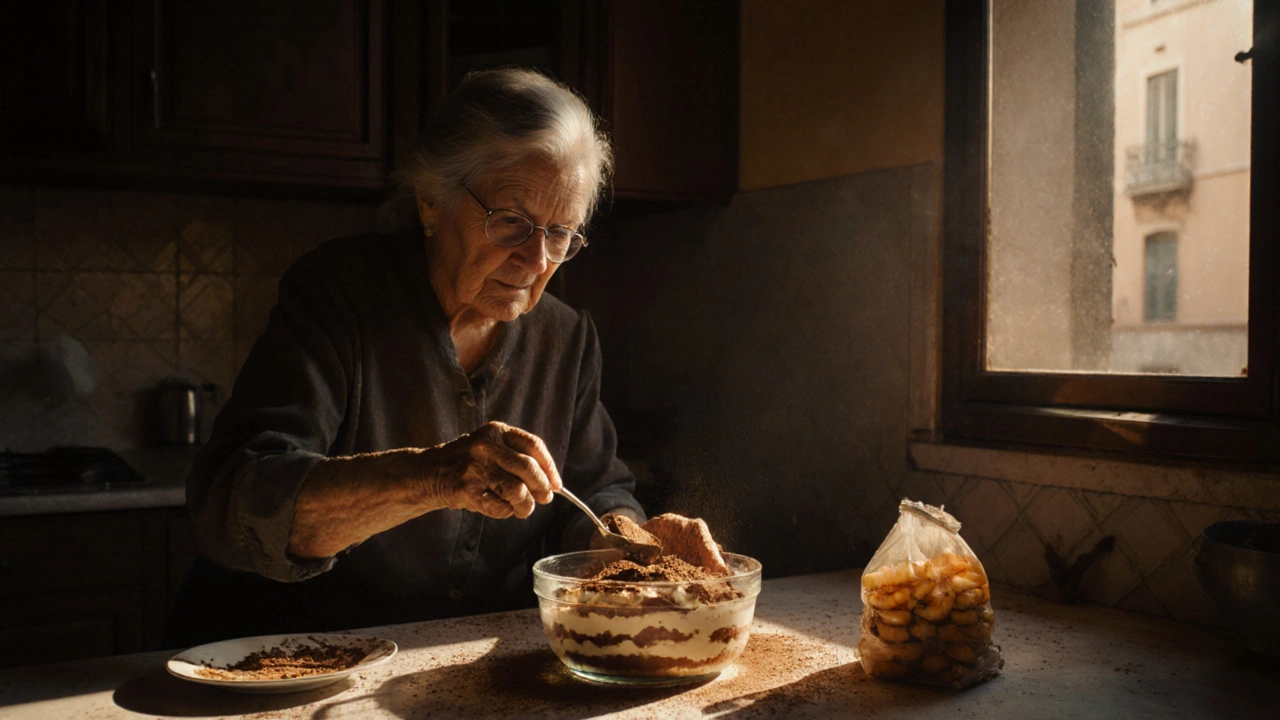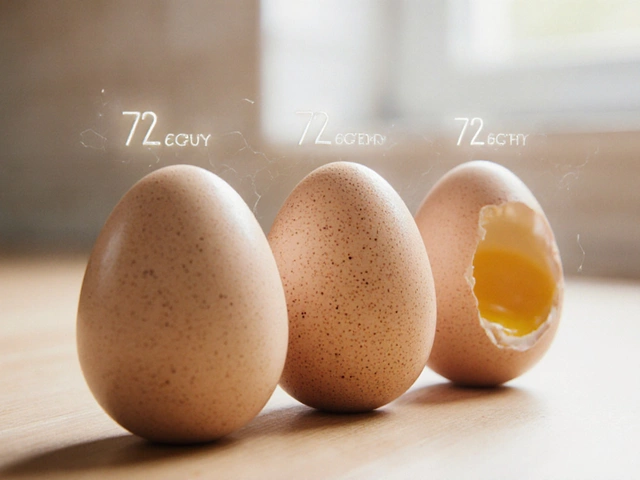Authentic Tiramisu Checker
Verify if your preparation matches traditional Italian methods. Follow the article's guidelines to make it truly authentic.
Ask any Italian what their favorite dessert is, and chances are they’ll say tiramisu. Not because it’s fancy, not because it’s expensive, but because it’s the one thing that shows up at every family gathering, holiday table, and Sunday lunch. It’s not just a dessert-it’s a ritual.
Where Tiramisu Really Comes From
People love to argue about where tiramisu was invented. Some say Venice. Others claim Treviso. But the truth is simpler: it was born in the Veneto region in the late 1960s. A restaurant called Le Beccherie in Treviso started serving it under the name “tireme su”, which means “pick me up” in the local dialect. The name stuck because of the caffeine from coffee and the sugar from the mascarpone-two things that give you that sweet, warm lift after a big meal.
Before tiramisu, Italians ate simpler sweets: cannoli, panna cotta, or biscotti dipped in wine. But tiramisu changed the game. It didn’t need an oven. It didn’t need fancy tools. Just a bowl, a whisk, and a few ingredients you already had in the kitchen. That’s why it spread so fast.
The Five Ingredients That Make It Real
Real Italian tiramisu has only five ingredients. No cream cheese. No whipped cream. No gelatin. No vanilla extract. Nothing extra.
- Coffee-strong, dark, and freshly brewed. Espresso is traditional, but any rich coffee works. It’s not just flavor-it’s the moisture that softens the ladyfingers.
- Ladyfingers (savoiardi). These are dry, sponge-like biscuits. They’re not meant to be soggy. They’re meant to soak up coffee just enough to become tender but still hold shape.
- Mascarpone. This is the heart of it. Not cream cheese. Not ricotta. Not yogurt. Real Italian mascarpone is thick, slightly sweet, and buttery. It’s made from heavy cream and citric acid, not rennet. It should be smooth, not grainy.
- Eggs. Separated. The yolks are whisked with sugar until pale and creamy. The whites are whipped to soft peaks and folded in. This is what gives tiramisu its lightness. No store-bought whipped topping can replace this.
- Cocoa powder. Bitter, unsweetened, and dusted on top. It’s not chocolate syrup. It’s not chocolate chips. It’s pure cocoa. That’s what makes the contrast pop-the creamy, sweet filling against the sharp, earthy dusting.
That’s it. No alcohol? Some recipes add Marsala or rum. That’s fine. But it’s optional. The original didn’t have it. The Italian nonnas who made this every Sunday didn’t need it. The coffee and the cocoa were enough.
Why It’s Not Just a Dessert-It’s a Memory
In Italy, tiramisu isn’t served on a fancy plate. It’s served straight from the dish it was assembled in-a glass bowl, a ceramic dish, sometimes even a loaf pan. You scoop it with a spoon. You eat it with a fork. No napkins needed. It’s messy. It’s real.
Think about it: you don’t make tiramisu because you’re trying to impress. You make it because you’re trying to comfort. It’s what you make when someone’s sick. When someone’s grieving. When someone just needs to feel like home.
My friend Luca, who grew up in Bologna, told me his grandmother made tiramisu every time his father came home from work. No special reason. Just because. “He’d walk in, take off his shoes, and she’d say, ‘Go wash your hands. Tiramisu’s ready.’” That’s the power of this dessert.

What Makes It Different From Other Desserts
Compare tiramisu to a cheesecake. Cheesecake is dense. It’s heavy. It’s meant to be a centerpiece. Tiramisu is the opposite. It’s light. It’s layered. It’s quiet. You don’t need a knife to cut it-you just scoop.
And unlike cakes that need frosting, decorations, or sprinkles, tiramisu doesn’t care about looks. It doesn’t need to be perfect. A little uneven layer? A few crumbs on the side? That’s fine. That’s how it’s supposed to be.
It’s also one of the few desserts that tastes better the next day. That’s because the coffee and mascarpone have time to marry. The ladyfingers soften fully. The cocoa settles in. You make it in the morning. You eat it after dinner. That’s the rhythm.
How to Make It Right (No Fluff, No Filler)
If you want to make tiramisu the Italian way, here’s how:
- Make strong coffee. Let it cool. Don’t use instant. Don’t use weak coffee. It’s the backbone.
- Separate 4 eggs. Whisk the yolks with 75g of sugar until pale and thick. Fold in 500g of mascarpone. Gently fold in the whipped egg whites.
- Dip each ladyfinger quickly-1 second per side-in the coffee. Don’t soak them. You want them soft, not mushy.
- Layer them in a dish. Spread half the mascarpone mix on top. Add another layer of dipped ladyfingers. Cover with the rest of the cream.
- Sift 2 tablespoons of unsweetened cocoa powder over the top. Cover with plastic wrap. Refrigerate for at least 6 hours, preferably overnight.
That’s it. No butter. No liqueur. No whipped cream. Just coffee, eggs, sugar, mascarpone, and cocoa. Five ingredients. One perfect dessert.

Why People Get It Wrong
Outside Italy, tiramisu has been twisted. You’ll see versions with:
- Whipped cream instead of egg whites-makes it heavy and artificial
- Chocolate shavings instead of cocoa-too sweet, too flashy
- Alcohol poured in like it’s a cocktail-drowns the coffee
- Store-bought ladyfingers soaked for minutes-turns it into a puddle
These aren’t mistakes. They’re misunderstandings. Tiramisu isn’t about adding more. It’s about getting the basics right.
There’s a reason Italian restaurants in New York or London serve tiramisu that tastes like a dessert from a 1990s magazine. They’re trying to make it look pretty. Italians are trying to make it feel true.
What to Serve With It
Nothing. That’s the answer. Tiramisu doesn’t need wine, espresso, or a scoop of ice cream. It stands alone. But if you want to pair it, go with a small cup of strong espresso. Or a glass of sweet dessert wine like Vin Santo. Just don’t overdo it. The dessert is already a full experience.
And never serve it warm. It’s meant to be cold. Chilled. Quiet. Like a pause in the middle of a long day.
Is Tiramisu Really the Favorite?
Yes. And here’s why: it’s not the most popular because it’s the most expensive. It’s not the most popular because it’s the most complicated. It’s the most popular because it’s the most honest.
It doesn’t hide behind sugar. It doesn’t pretend to be something it’s not. It’s coffee. It’s cream. It’s cocoa. It’s time. And it’s made with care.
Ask an Italian what they love most about their food, and they’ll tell you it’s not the fancy restaurants. It’s the simple things made well. Tiramisu is that thing.
Is tiramisu originally from Italy?
Yes. Tiramisu was created in the Veneto region of Italy in the late 1960s, most likely at a restaurant called Le Beccherie in Treviso. It’s a distinctly Italian dessert, made with Italian ingredients like mascarpone and savoiardi. While it’s now popular worldwide, its roots are firmly Italian.
Can I make tiramisu without alcohol?
Absolutely. The original recipe doesn’t include alcohol. The coffee provides enough flavor and depth. If you want to add Marsala or rum, that’s fine-but it’s optional. Many Italian families make it without any alcohol at all, especially when serving children or during religious holidays.
Why does my tiramisu turn out watery?
It’s usually because the ladyfingers were soaked too long or the coffee was too thin. Dip them for only one second per side-just enough to soften them. Also, make sure your mascarpone is thick and not runny. If it’s too soft, chill it before mixing. And never use whipped cream instead of egg whites-it doesn’t set the same way.
Can I use store-bought mascarpone?
Yes, but check the label. Real mascarpone has only two ingredients: cream and citric acid. If it lists stabilizers, gums, or thickeners, it’s not authentic. You’ll notice the texture is grainy or too stiff. For the best results, choose a brand that’s thick, creamy, and slightly sweet-like the kind you’d find in an Italian grocery store.
How long does tiramisu last?
It keeps well in the fridge for up to 4 days, covered tightly with plastic wrap. The flavor improves after 24 hours. After that, the ladyfingers start to break down, and the texture gets mushy. Don’t freeze it-the coffee and cream separate. Best eaten fresh from the fridge.





